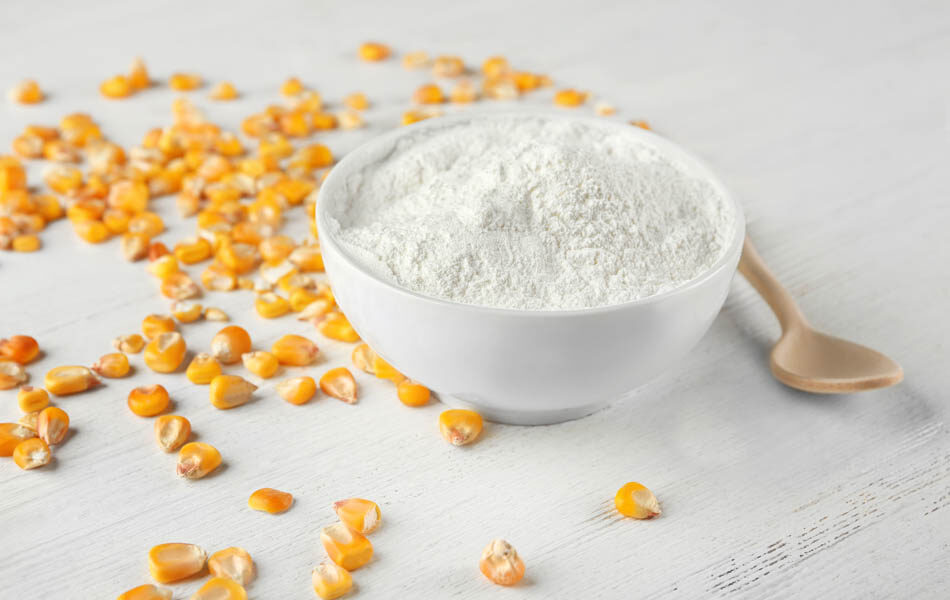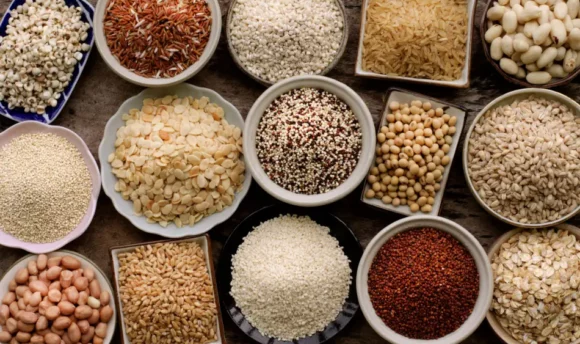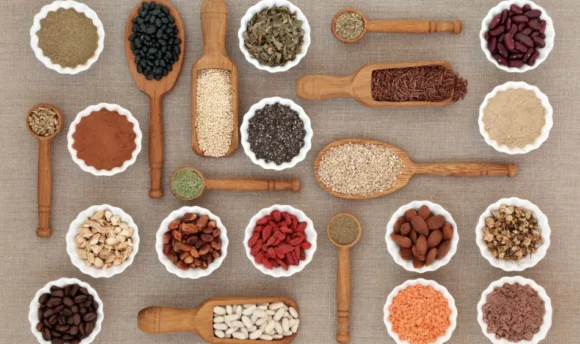Is Cornstarch Good or Bad for You?
Commonly used as a thickening agent for sauces, stews, soups, and more, you may wonder if cornstarch has any health benefits. Is cornstarch healthy? Let’s find out!

Cornstarch is a versatile white baking powder that can be found in almost every kitchen pantry, similar to potato starch, rice flour, and tapioca flour. However, when added to recipes, cornstarch causes a thickening called gelatinization.
Typically, cornstarch is added to a liquid fat, such as butter or oil, in a saucepan to make a roux. The roux is often a base upon which a sauce is made.
This article will discuss cornstarch’s potential benefits and downsides, as well as its nutritional information and how to use it.
Is Cornstarch Good or Bad for You?
Cornstarch is unhealthy for you because while it is low in calories and free of fat, sugar, sodium, and cholesterol, it is high in carbs. It also is significantly lacking vitamins, minerals, and fibers.
3 Benefits of Cornstarch
Now let’s dive into some of the potential health benefits of cornstarch, from taste and texture to vitamins and minerals.
#1 It increases the palatability of foods
The primary function of cornstarch is to thicken sauces, stews, gravies, and more, similar to tapioca starch. By adding cornstarch into our recipes, it makes the foods more palatable and pleasant to eat.
Modified cornstarch is an important and commonly used food additive as well. Modified cornstarch is “modified” or changed to have different properties depending on the use.
Some modified cornstarch can be used for preventing caking when cooking, stabilizing, emulsifying (combining fat and water), moisture-retaining, and much more.
Modified cornstarch is also important in improving the quality of the foods you cook and bake.
In other words, cornstarch (and modified cornstarch) is an inexpensive and accessible way to make your foods more enjoyable to eat!
#2 It provides some calcium
Cornstarch provides a very small amount of calcium. Unfortunately, cornstarch does not contain significant amounts of any other vitamin or mineral.
Overall, calcium is important for supporting strong bones and teeth. According to the National Institutes of Health, calcium also plays a significant role in blood vessel constriction and dilation, blood clotting, muscle functioning, and much more.
#3 It’s gluten-free
Another benefit of cornstarch is that it is naturally gluten-free. Gluten is a type of protein that has no impact on most individuals. However, it affects some, such as those diagnosed with celiac disease, gluten intolerance, or a gluten allergy.
For these individuals, cornstarch can be a great way to thicken sauces, stews, and soups without regular flour.
However, other flour, such as rice flour, potato starch, and tapioca flour, can be used instead, providing more nutrition. Yet, cornstarch is likely the most inexpensive and accessible option for gluten-free flour.
3 Possible Side Effects of Cornstarch
In addition to these potential health benefits, cornstarch has some health side effects and drawbacks as well. So, let’s talk about them!
#1 May increase blood sugar levels
Cornstarch is a significant source of carbohydrates and starch, as the name suggests. There are over 7 grams of carbohydrates in a typical serving of cornstarch, which is about 8 grams or a tablespoon.
While it doesn’t have an extremely large amount of carbs, it doesn’t contain any protein, fiber, or fat to slow down the digestion and absorption of the sugars in the starch.
This is why it is important to mention that people who are diagnosed with diabetes should reconsider eating not only cornstarch itself but also the dishes that are made with it.
Due to its high carbohydrate content, cornstarch will drastically increase blood sugar levels and promote quick insulin response leading to diabetes side effects.
If you are not sure what foods are diabetes-friendly and you have trouble monitoring and managing diabetes, we recommend checking the Klinio app.

- Personalized and diabetes-safe meal plan
- An integrated shopping list that matches the meal plan
- No-equipment home workouts
- All-in-one health and progress tracker
- Detailed activity log
#2 May promote poor bowel regularity
Many recipes allow you to substitute regular white or wheat flour with cornstarch (which is also known as corn flour). However, unlike many other flour types, cornstarch does not have any dietary fiber.
According to the Mayo Clinic, fiber is essential in a healthy and balanced diet because it promotes regularity in bowel movements, slows down the digestion and absorption of sugars in the foods we eat (therefore, lowering blood sugar levels), and can even lower cholesterol.
Other flours that also can be used as a thickener are higher in fiber, such as refined white flour or wheat flour.
There are even other gluten-free foods that contain fiber as well.
#3 Can cause digestive upset
Unfortunately, consuming raw or undercooked cornstarch can cause uncomfortable digestive symptoms, such as flatulence or bloating. However, the heating process during cooking helps break down the problematic compounds.
Therefore, heating and cooking your cornstarch drastically reduces the prevalence of gastrointestinal symptoms.
Cornstarch Nutrition Facts
Now that we have covered the potential benefits and side effects of consuming cornstarch, let’s discuss the nutritional information.
Nutritional value of cornstarch per 100g
| Calories/Nutrient (per 100g) | Amount |
| Calories (kcal) | 381 |
| Sodium (mg) | 9 |
| Net Carbs (g) | 91.3 |
| Fiber (g) | 0.9 |
| Sugar (g) | 0 |
| Fats (Total) | 0.05 |
| Protein (g) | 0.26 |
| Cholesterol (mg) | 0 |
Source: https://fdc.nal.usda.gov/fdc-app.html#/food-details/169698/nutrients
High in calories
A tablespoon of cornstarch contains about 30 calories. While this may not seem like much, it can quickly add up in recipes that call for a few tablespoons or more of cornstarch.
Low in fats
Cornstarch has zero grams of total fat. However, healthier and more nutrient-dense flours, such as oat flour or wheat flour, also are free of fat but contain more vitamins and minerals.
High in carbohydrates
Cornstarch is made from ground-up corn, which is a starchy vegetable. Therefore, cornstarch is very high in carbohydrates, with over 90 grams in 100 grams of cornstarch.
Carbohydrates provide energy but can also cause weight gain when consumed in excess.
Low in vitamins and minerals
Cornstarch does not have any essential nutrients, such as vitamins and minerals, with the exception of calcium. This is because the vitamins and minerals are stripped out during the processing of cornstarch from corn.
Although, since you typically only use a few tablespoons of cornstarch at a time, the benefits from calcium are likely very minimal.
Healthy Ways to Use Cornstarch in Recipes
Since cornstarch is commonly used as a thickener in sauces, let’s walk through an example recipe for an easy and healthy vegan gravy! This sauce is also perfect when served with mashed potatoes, beef stew, and more. Read on!
Ingredients
- 1 tablespoon of extra virgin olive oil
- 3 tablespoons of cornstarch
- 1 teaspoon of honey mustard
- 1/2 teaspoon black pepper
- 1 teaspoon of garlic powder
- A pinch of salt
- 1 1/2 cups of low-sodium vegetable broth
Directions
- Heat oil in a saucepan on low to medium heat.
- Stir in cornstarch, honey mustard sauce, and seasonings.
- Add broth, simmer on low heat, and whisk until thick and smooth. Strain if desired.
For more easy and healthy recipes, check out the DoFasting app! DoFasting provides thousands of recipes that are hand-picked by nutrition experts.

- 5,000+ healthy recipes
- Healthy desserts
- Improved eating habits
- Calorie tracker to track daily caloric intake
- Full guidance on successful diet
FAQs
Yes, it is safe to eat cornstarch that has been cooked and used in a sauce, stew, gravy, and more.
Cornstarch contains some carbohydrates and calories but is typically only used in very small amounts. Therefore, it is unlikely to cause weight gain unless consumed in excess.
A tablespoon of cornstarch, which is approximately 8 grams, contains about 7 grams of carbohydrates. Therefore, it can increase blood sugar levels.
Cornstarch is not as healthy as flour because flour contains essential nutrients, such as vitamins, minerals, and fiber, while cornstarch does not.
Eating cornstarch provides some energy to your body as it is primarily composed of carbohydrates.
A Word From a Nutritionist
Often used in batters, such as for fried fish, or sauces, like teriyaki sauce, cornstarch is a common thickener likely found in many kitchen pantries around the world.
Using cornstarch makes your sauces more appealing and palatable. In addition, it can be used as a gluten-free alternative to sauce recipes that call for wheat flour containing gluten.
Besides texture modification to your foods, cornstarch in typical amounts does not contain any sugar, fat, cholesterol, or sodium.
However, it also does not contain a significant amount of nutrition, such as vitamins, minerals, and fiber.
It can safely and healthily be a part of a well-balanced diet as long as it is consumed in moderate amounts, such as a few tablespoons.
A popular substitute for corn flour is arrowroot flour. Arrowroot flour also contains more nutrients, such as dietary fiber.
Conclusion
Cornstarch is a high-carbohydrate flour that many use to thicken sauces, stews, and gravies. Since it is naturally gluten-free, cornstarch can be consumed by those with celiac disease, a gluten allergy, or gluten intolerance.
While it does have some health benefits, it is unlikely that these benefits are making an impact at such a small amount.
However, cornstarch can potentially cause some symptoms of gastrointestinal upset, such as bloating, if it is not fully cooked.
Replacing cornstarch with more nutritious flour like whole-wheat flour can increase your vitamin, mineral, and fiber intake.

















































 Select your language:
Select your language: 








